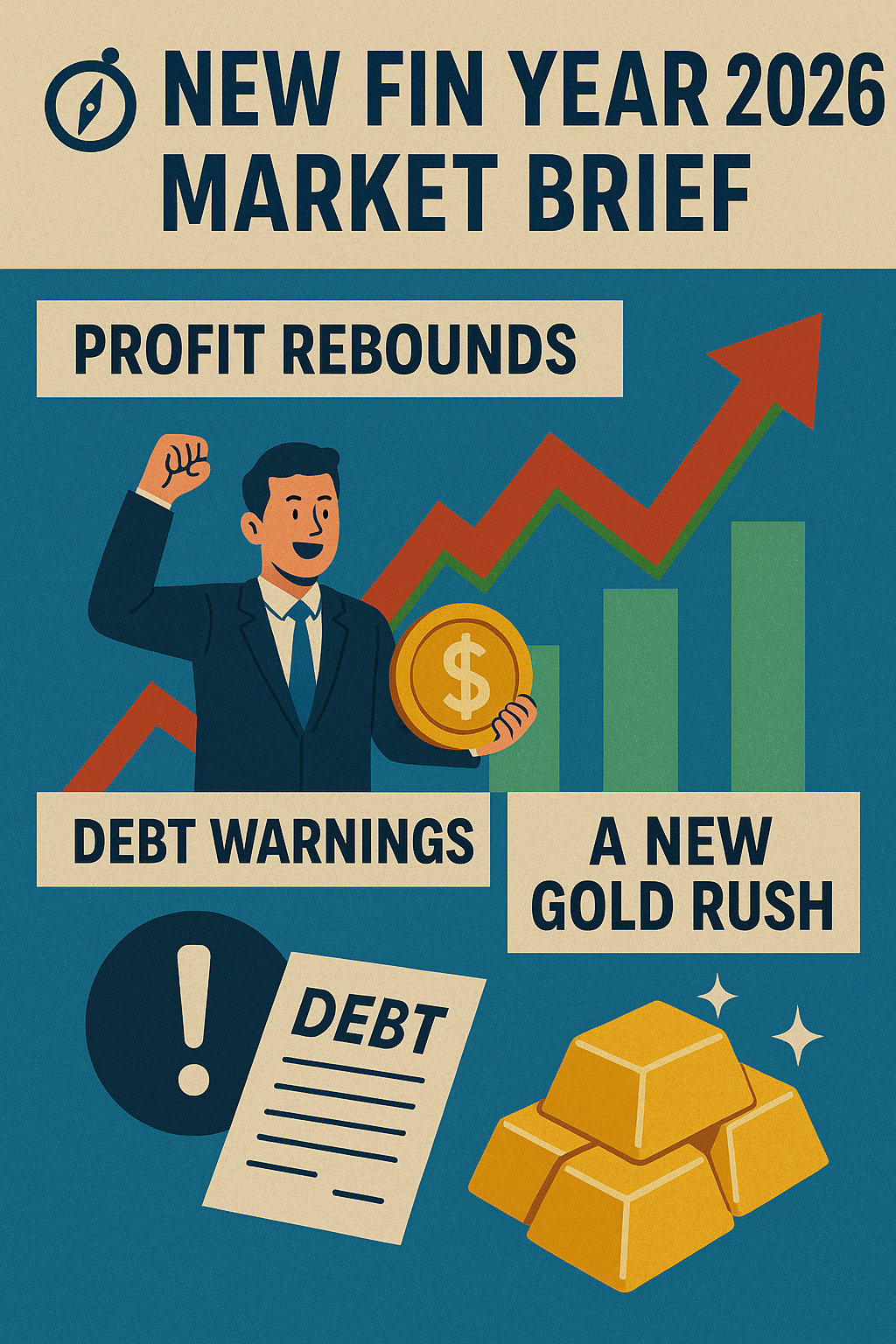
🧭 New Fin Year 2026 Market Brief: Profit Rebounds, Debt Warnings, and a New Gold Rush
Published: April 2, 2025
By: ProfitFromIt
As we step into Q1 2026, investors face a landscape marked by stark contrasts—booming corporate profits in the US clash with deepening debt concerns globally, and a record-setting gold rally signals flight to safety amid rising geopolitical tensions.
Here are the key developments investors should know, based on insights from the World Economic Forum (WEF) and recent financial data.
🇺🇸 US Corporate Profits: Rebound Meets Reality Check
Q4 2024 delivered a strong rebound in US corporate earnings, with profits rising $204.7 billion, according to the Bureau of Economic Analysis. This upswing was largely driven by pre-emptive inventory stockpiling and robust consumer spending ahead of new trade policies.
However, early 2025 (World Financial Year) brings new headwinds:
President Trump’s 25% tariff on imported vehicles (effective April 2) is expected to ripple through supply chains, especially auto and manufacturing sectors.
Global markets reacted sharply: stocks plunged on March 31, while gold hit record highs.
Early Q1 GDP estimates are now below 1.5%, with slowing consumer spending and restrained corporate investment.
🔍 Investor Insight:
While the Q4 rebound may extend into early 2025, sustained earnings growth is uncertain. Tariffs, recession risks, and tighter consumer wallets could pressure margins. This is a good time to stress-test portfolios against trade-sensitive sectors.
🌍 Global Debt: OECD Warns of Mounting Risks
The OECD’s 2025 Global Debt Report underscores a critical macro risk: soaring global debt in a rising interest rate environment.
📊 Key Numbers:
$25 trillion borrowed globally in 2024—almost 3x 2007 levels.
OECD sovereign debt-to-GDP set to reach 85% by year-end.
$35 trillion in corporate bond debt, much of it used for buybacks and refinancing, not productivity.
45% of sovereign debt maturing by 2027—raising refinancing risks.
💬 OECD Secretary-General Mathias Cormann cautioned:
"Debt levels are surging at a time of increasing borrowing costs and volatility... prioritizing productivity-enhancing investments is key."
🔍 Investor Insight:
High-debt corporates and sovereigns face elevated refinancing risk. Look for companies with strong cash flows, manageable debt ratios, and productive capital allocation. Investors may also consider bond laddering strategies or short-duration debt to navigate rate volatility.
🌟 Gold, ETFs, Real Estate: Thematic Trends Gaining Momentum
🪙 Gold Surges:
Up 18% in Q1 2025 – biggest quarterly gain since 1986.
Fueled by:
Central bank demand
ETF inflows
Rate cut expectations
📈 ETF Flows:
Asset managers are launching defence-focused ETFs in Europe amid military spending boosts and geopolitical tensions.
🏠 Real Estate:
Bank of America saw an 80% spike in mortgage applications between Jan–Mar 2025.
Lower long-term bond yields and increased housing supply are supporting the recovery.
🔍 Investor Insight:
Gold offers safe-haven appeal amid rising uncertainty.
Defence and infrastructure ETFs may benefit from long-term government policy tailwinds.
Real estate exposure, especially in suburban and mid-tier housing, could perform well under current rate conditions.
🇨🇳 China and 🇬🇧 UK: Strategic Moves Worth Watching
🇨🇳 China Stimulus:
$69 billion investment by the Finance Ministry into state banks via share placements.
Aims to strengthen capital buffers and support continued stimulus.
🇬🇧 UK Bond Market Relief:
Pension reform may mitigate £500 billion gilt market selloff.
New rules allow surpluses to be reinvested into businesses, slowing pension fund exits from bonds.
🔍 Investor Insight:
These moves suggest regulatory cushioning of financial markets in two major economies. Watch for China's broader stimulus effects on commodities and EMs, and the UK bond market's stabilization as a sign of shifting pension dynamics.
🌏 Emerging Markets Outlook: India in Focus
Though India wasn’t directly mentioned in the WEF article, global themes have clear spillovers:
Tariff tensions and slowing developed market growth could pressure India’s export sectors.
At the same time, capital may rotate into high-growth EMs, including India, amid rate pauses in the West.
Domestic momentum—via government capex, digital infrastructure, and consumption—remains strong.
🔍 Investor Insight:
India remains a favorable long-term growth market, but investors should hedge for currency volatility and potential capital flow shocks. Focus areas: financial services, consumer tech, renewable energy, and infrastructure.
📌 Summary: What Should Investors Do?
📣 Final Word
The start of 2025 has brought both profit optimism and policy-induced volatility. Investors should remain alert to macro risks, diversify across regions and themes, and position portfolios for resilience and value creation in a shifting global landscape.
